
The Sparidae are a family of fish in the order Perciformes, commonly called sea breams and porgies. The sheepshead, scup, and red seabream are species in this family. Most sparids are deep-bodied compressed fish with a small mouth separated by a broad space from the eye, a single dorsal fin with strong spines and soft rays, a short anal fin, long pointed pectoral fins and rather large firmly attached scales. They are found in shallow temperate and tropical waters and are bottom-dwelling carnivores.

Lepomis is a genus of freshwater fish in the sunfish family, Centrarchidae, in the order Perciformes. Perhaps the most recognizable species of this genus is the bluegill.
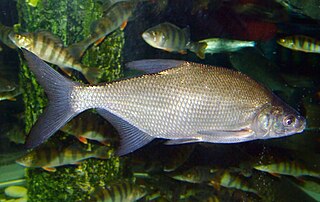
The common bream, freshwater bream, bream, bronze bream, or carp bream, is a European species of freshwater fish in the family Cyprinidae. It is now considered to be the only species in the genus Abramis.

Chilotilapia is a genus of freshwater fish in the cichlid family. It contains the sole species Chilotilapia rhoadesii, the Malawi bream, which is endemic to Lake Malawi in East Africa, where it prefers areas with muddy substrates from the shallows to quite deep waters. Its primary food consists of Melanoides and Lanistes snails. It can reach a length of 22.5 centimetres (8.9 in) TL. Though commonly called a "bream", this is due to its looks as it is quite unrelated to the breams proper, which are cypriniform fishes. This species is also found in the aquarium trade.
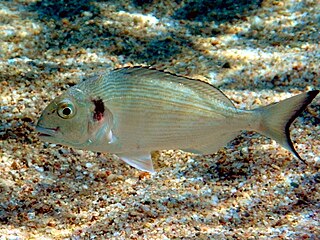
The gilt-head (sea) bream, called Orata in antiquity and still today in Italy, is a fish of the bream family Sparidae found in the Mediterranean Sea and the eastern coastal regions of the North Atlantic Ocean. It commonly reaches about 35 centimetres (1.15 ft) in length, but may reach 70 cm (2.3 ft) and weigh up to about 7.36 kilograms (16.2 lb).

Vimba vimba, called also the vimba bream, vimba,zanthe, or zarte, is a European fish species in the family Cyprinidae. It largely lives in the sea but makes an annual migration up-river each year to breed.

Acanthopagrus butcheri, the black bream but also commonly known as the southern black bream, southern bream and blue-nosed bream, is a species of marine and freshwater fish of the porgy family, Sparidae. It is a deep-bodied fish, occasionally confused with other similar species that occur within its range, but is generally distinguished from these species by a lack of yellow ventral and anal fins. Southern black bream are endemic to Australia, inhabiting the southern coast from Shark Bay in Western Australia to Mallacoota, Victoria, as well as Tasmania.

Acanthopagrus australis, the yellowfin bream, also known as sea bream, surf bream, silver bream or eastern black bream, is a species of marine and freshwater fish of the porgy family, Sparidae. It is a deep-bodied fish, occasionally confused with Acanthopagrus butcheri, but is generally distinguished by its yellowish ventral and anal fins. It is a popular target for recreational fisherman due to its capacity to fight well above its weight coupled with its table quality.
Sphaerothecum destruens is a parasite of fish. It was first discovered in the United States in association with invasive species including topmouth gudgeon, but was found to be the causative agent of a disease in the UK affecting salmonid species such as Atlantic salmon and brown trout. It is thought to pose more of a risk in Europe than in the US, as native species there are more susceptible to the parasite. The disease causes high rates of morbidity and mortality in a number of different salmonid species and can also infect other UK freshwater fish such as bream, carp, and roach. The genus Sphaerothecum is closely related to the genera Dermocystidium and Rhinosporidium.
Dendronucleata is a genus of small parasitic spiny-headed worms. It is the only genus in the family Dendronucleatidae. This genus contains three species that are distributed globally, being collected in North America and Asia. The distinguishing features of this genus among Archiacanthocephalans is the presence of randomly distributed dendritically branched giant hypodermic nuclei. Dendronucleata parasitize freshwater fish and a salamander by attaching themselves in the intestines using their hook covered proboscis and adhesives secreted from cement glands.
The Wuchang bream is a species of cyprinid fish native to bodies of water throughout the Yangtze basin, China, including Liangzi Lake. It is an important object of fish farming, and in 2012 its total production ranked 12th on the world list of most important fish species in aquaculture, with a total weight of 0.71 million tons and value of 1.16 billion US dollars.
Megalobrama elongata is a species of ray-finned fish in the genus Megalobrama.
Megalobrama mantschuricus is a species of ray-finned fish in the genus Megalobrama.

The black Amur bream is a species of freshwater cyprinid fish in the genus Megalobrama.
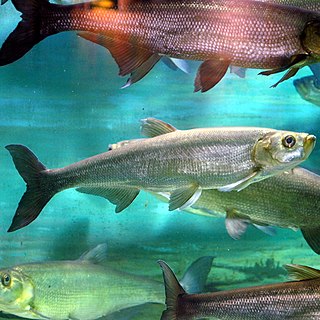
The Cultrinae are one of at least 13 subfamilies of cyprinid fish. It contains ten genera.
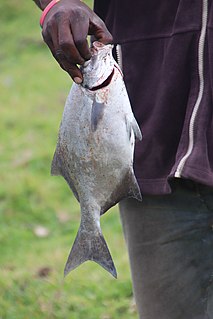
The stone bream is a species of marine ray-finned fish, a sea chub from the family Kyphosidae, which is native to the Indian Ocean coast of Africa where it can be found along rocky coasts from Mozambique to South Africa. This species grows to a length of 50 centimetres (20 in) SL though most do not exceed 18 centimetres (7.1 in). The greatest recorded weight for this fish is 2.6 kilograms (5.7 lb). This species is commercially important and is also popular as a game fish. This species is the only known member of its genus.
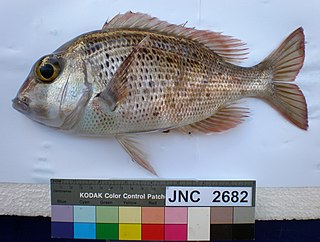
Gymnocranius is a genus of emperors native to the Indian Ocean and the western Pacific Ocean.
Tenacibaculum is a Gram-negative and motile bacterial genus from the family of Flavobacteriaceae.
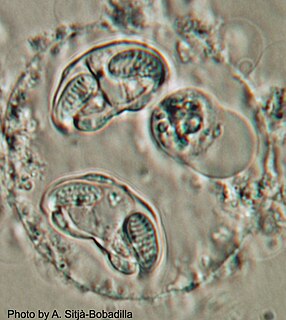
Enteromyxum leei is a species of myxozoan, histozoic parasite that infects the intestinal tract and sometimes associated organs, like gall bladder and liver, of several teleostean fish species. Myxozoans are microscopic metazoans, with an obligate parasitic life-style. The parasite stages of this species live in the paracelullar space between fish enterocytes. It is the causative agent of enteromyxosis, or emaciative disease, also known as “razor blade syndrome” in sparid fish. E. leei has a wide host and geographical range within marine fish, and even freshwater fish have been infected experimentally. E. leei initially emerged in the Mediterranean in the late 1980s and it is believed to have been unintentionally introduced into the Red Sea. Its pathogenicity and economic impact depend on the host species. In the gilt-head seabream, it is manifested as a chronic disease that provokes anorexia, delayed growth with weight loss, cachexia, reduced marketability and increased mortality. In other species, it has no clinical signs. In sharpsnout seabream, infection results in very high mortality rates, which have pushed fish farmers to abandon the culture of this fish species.













